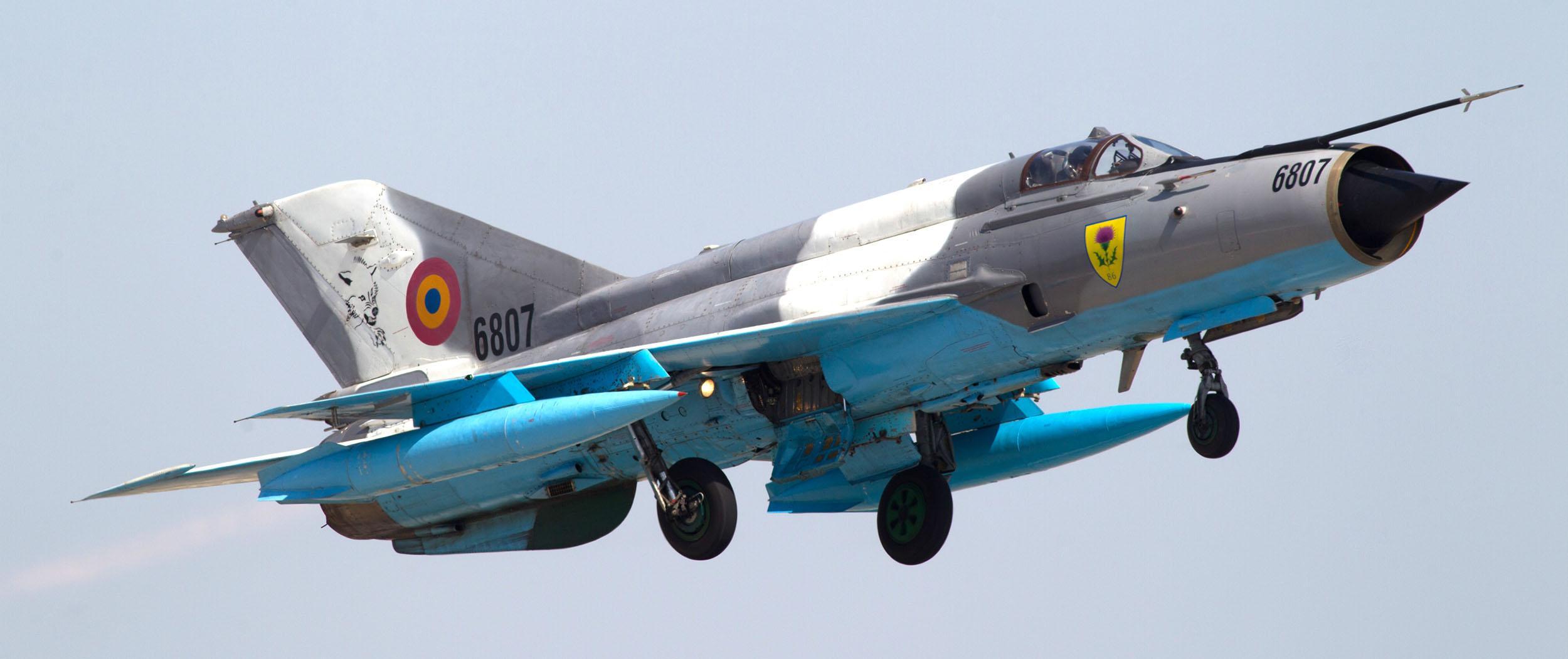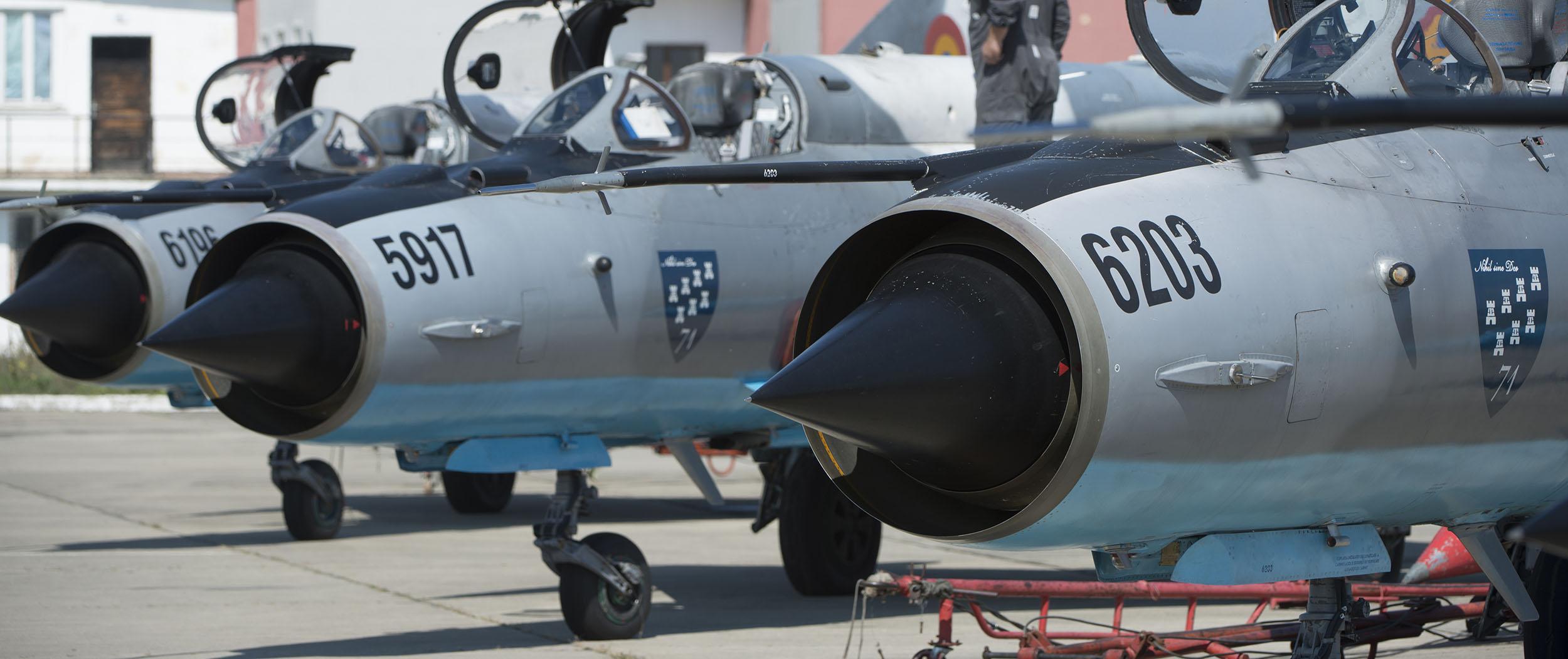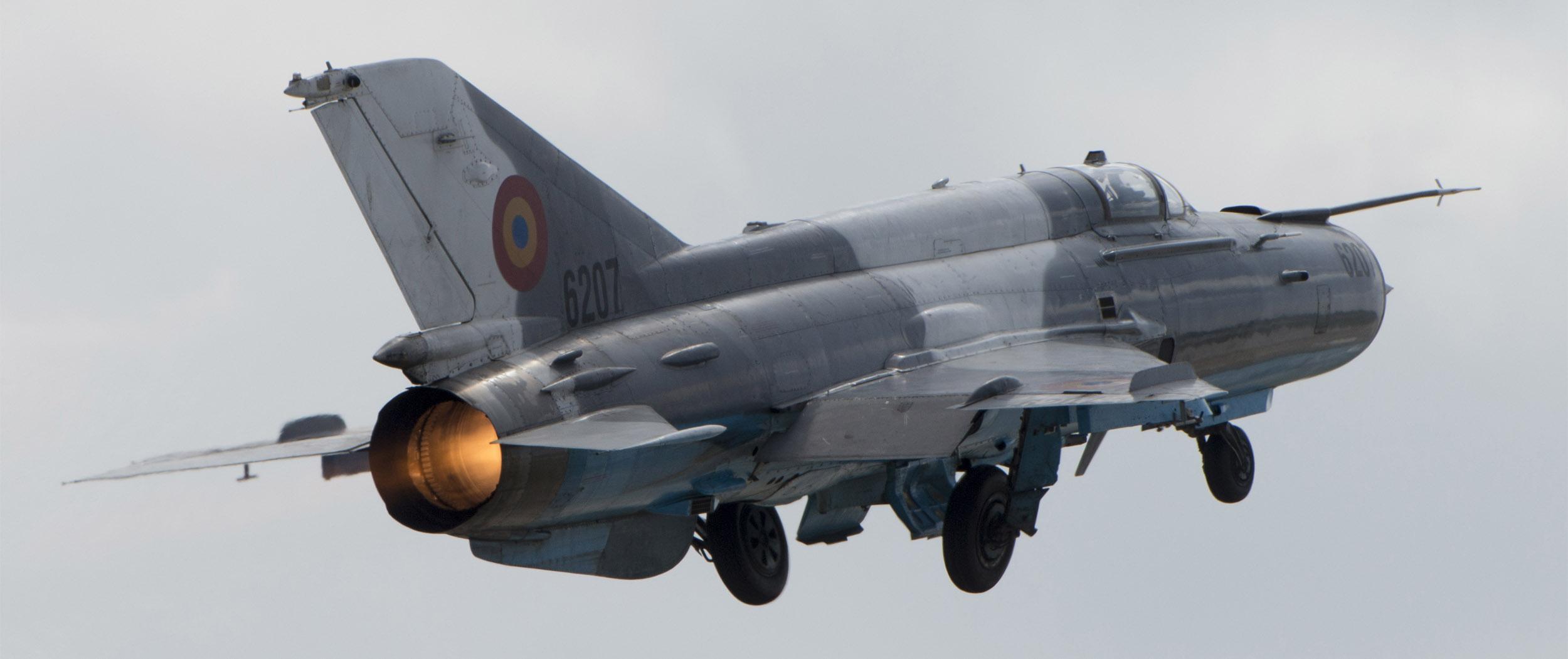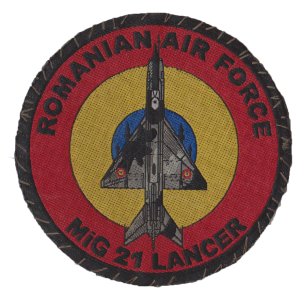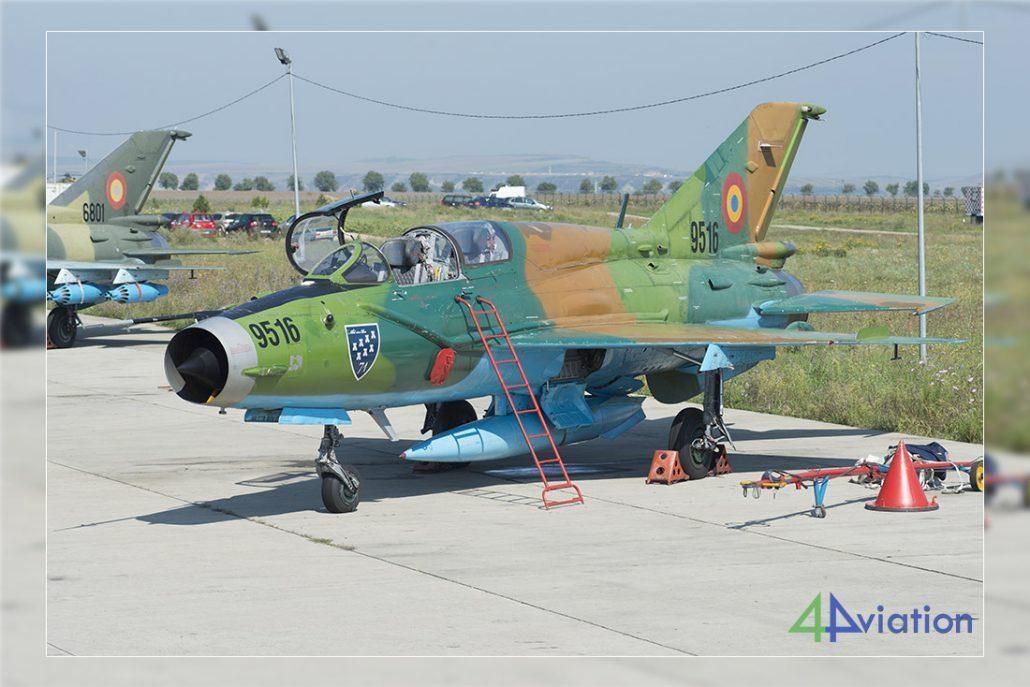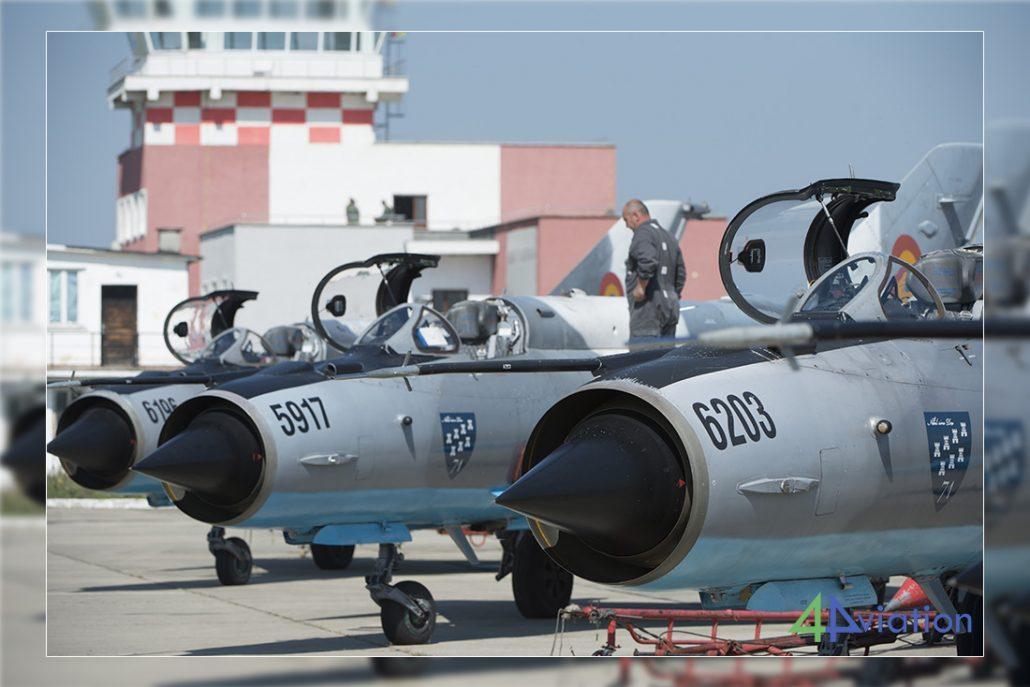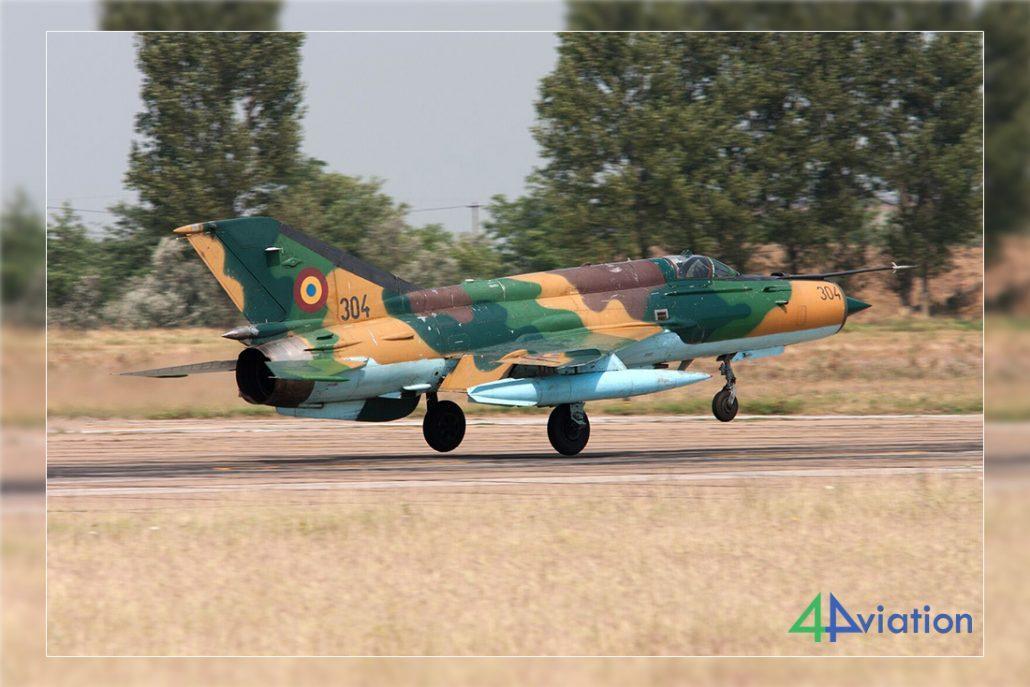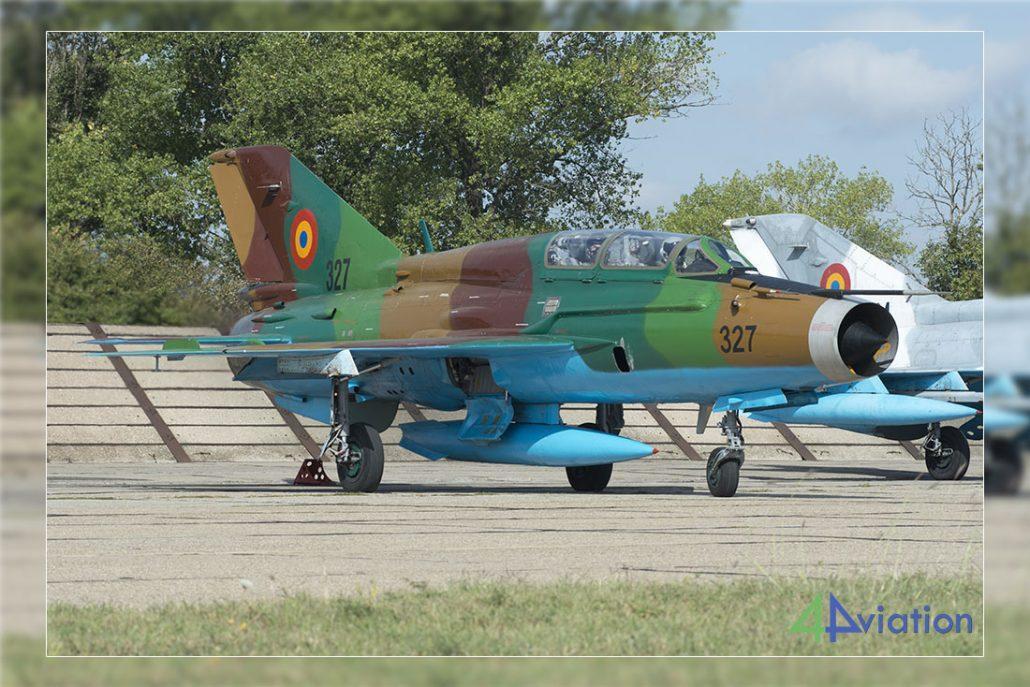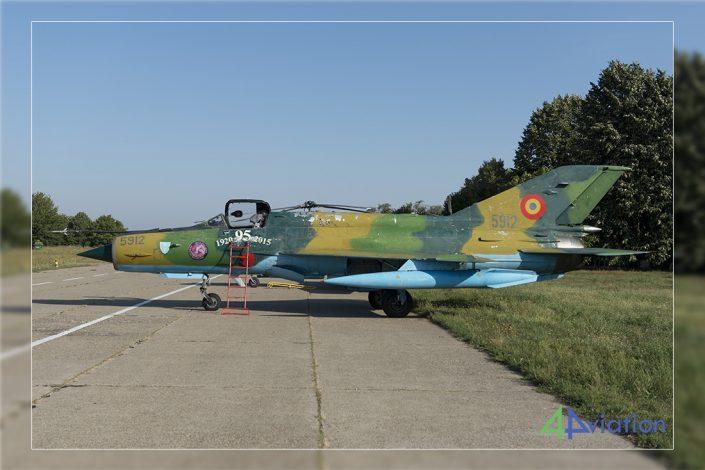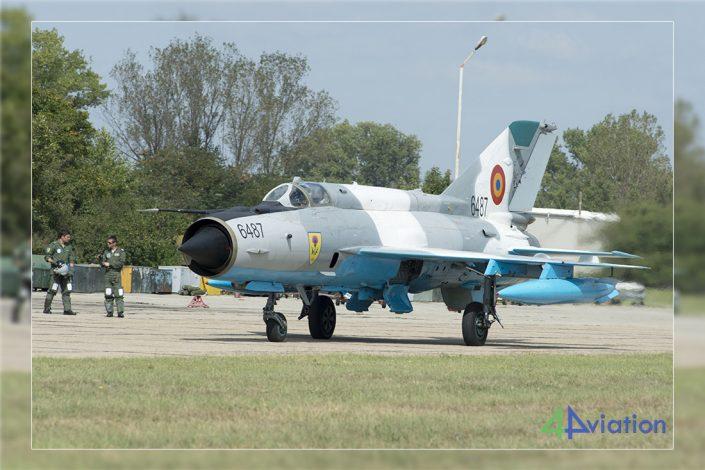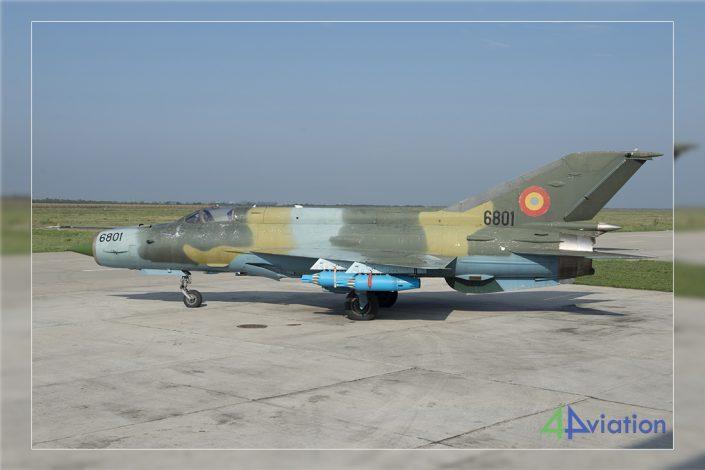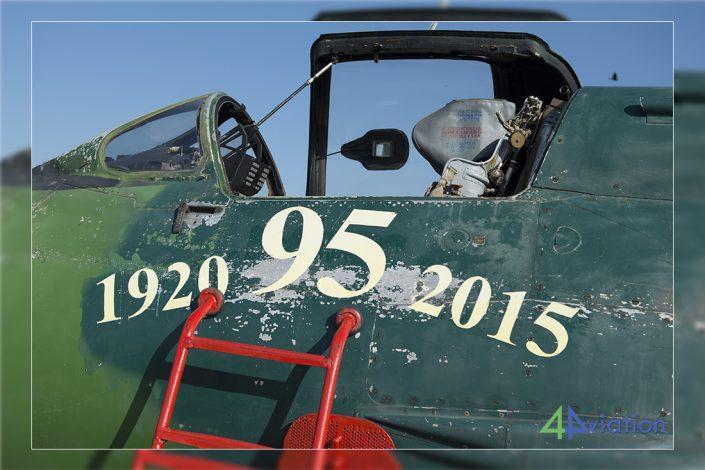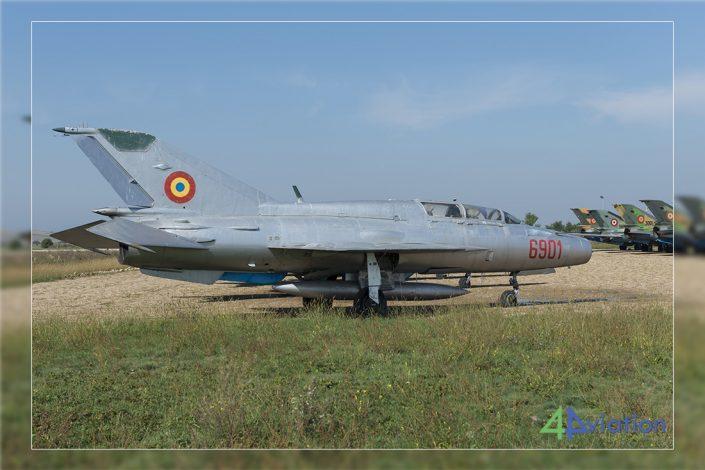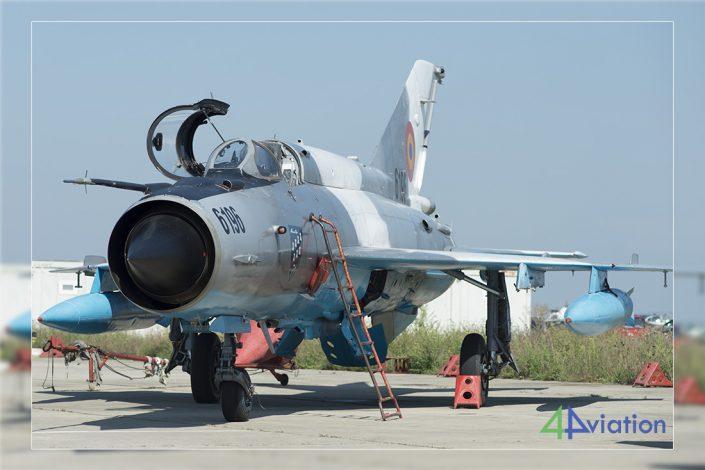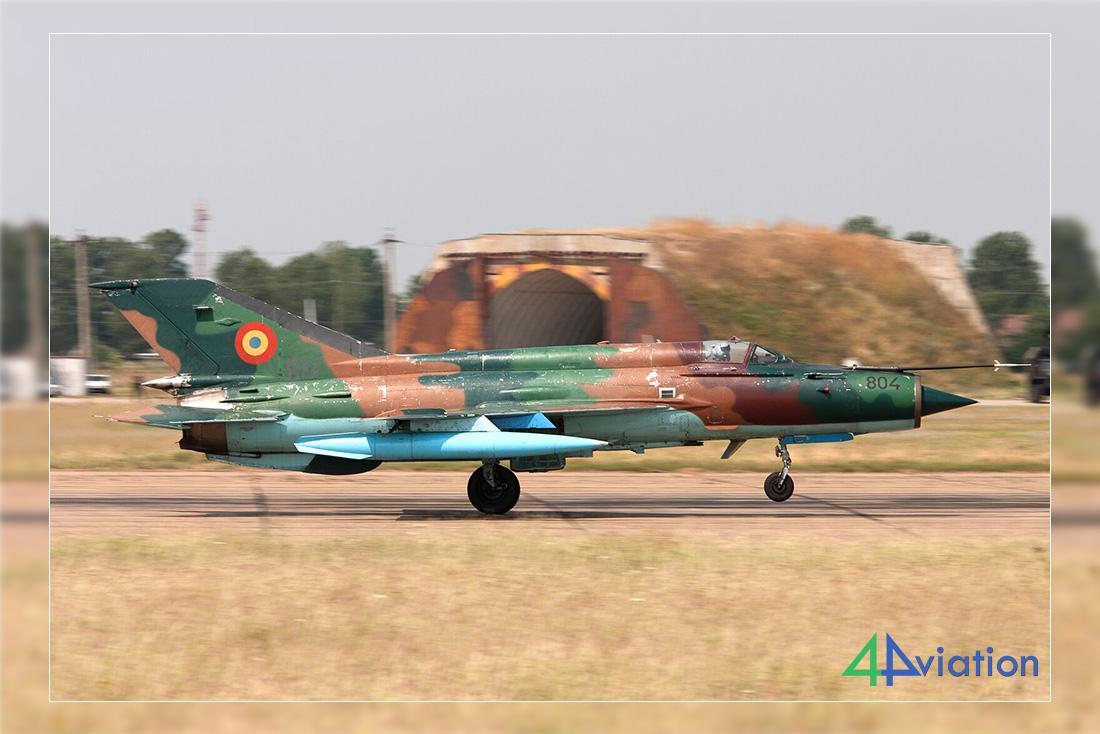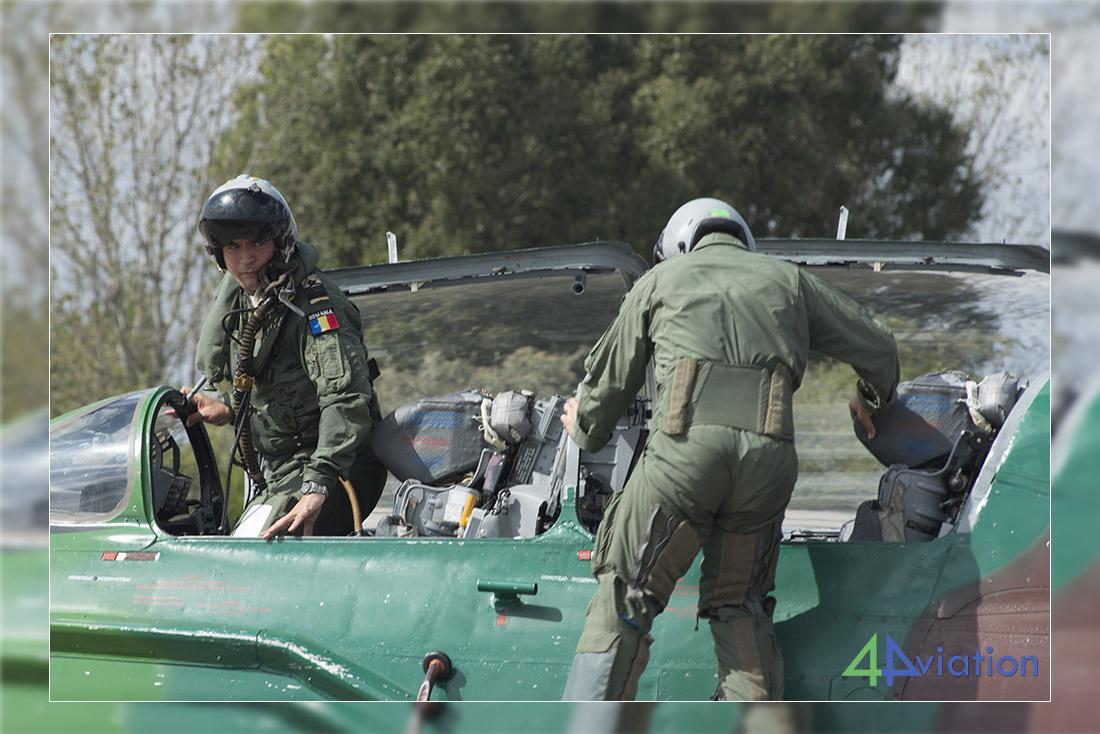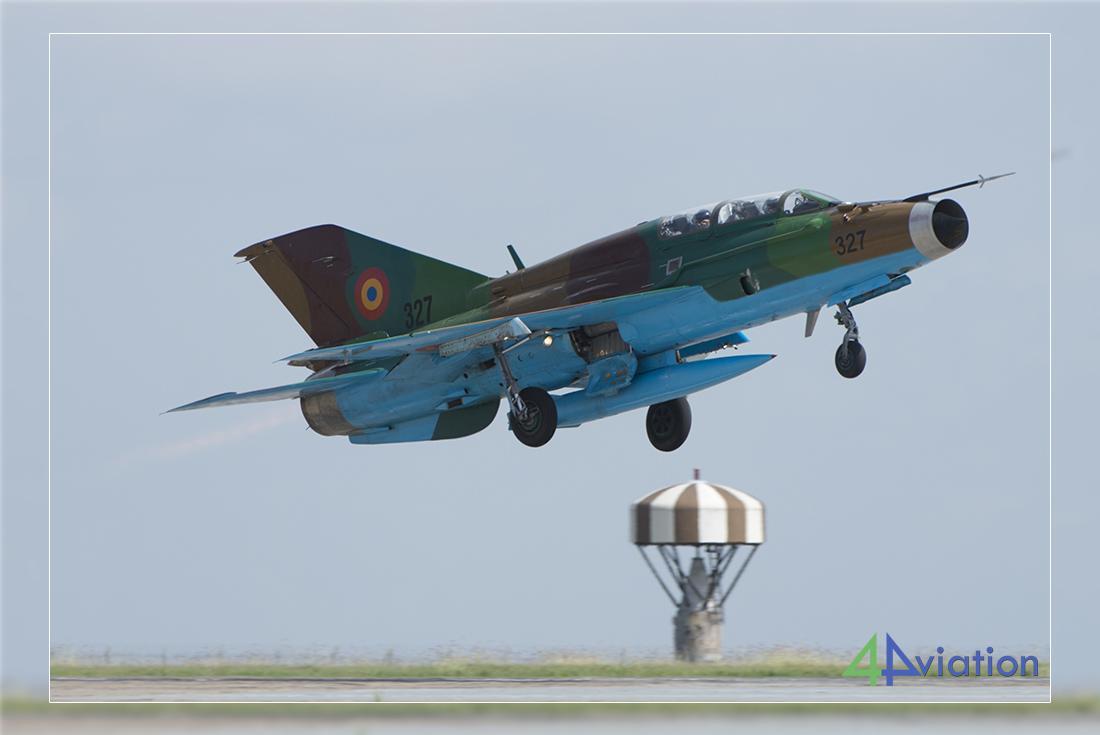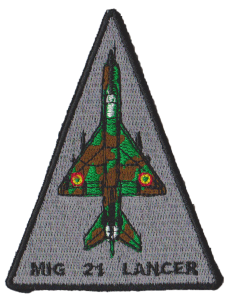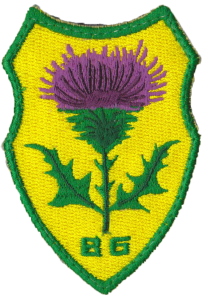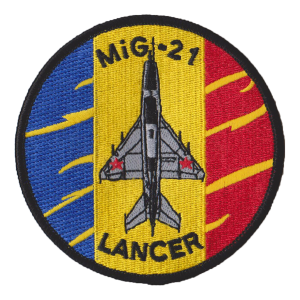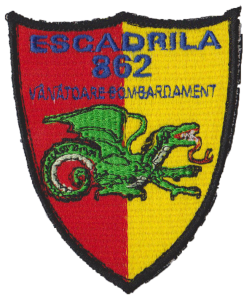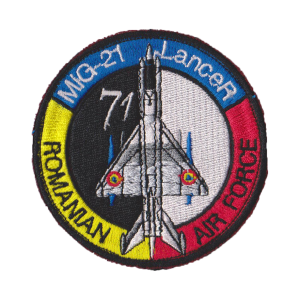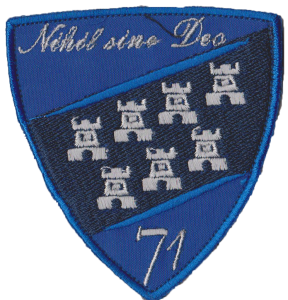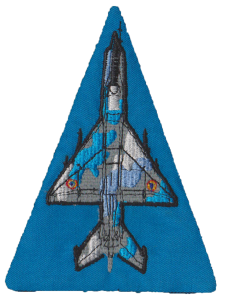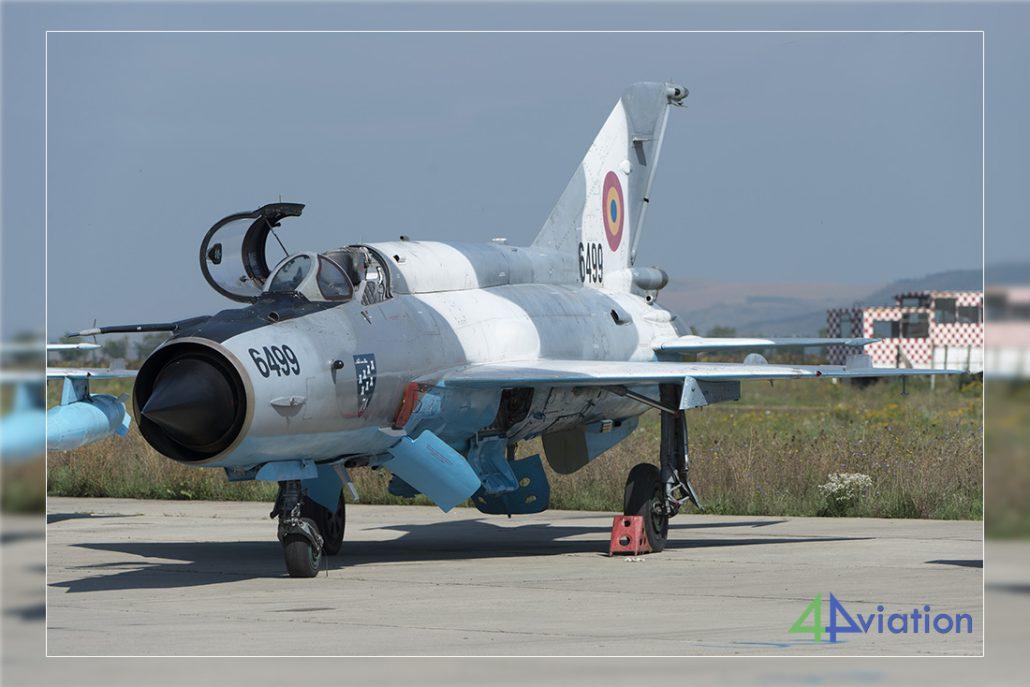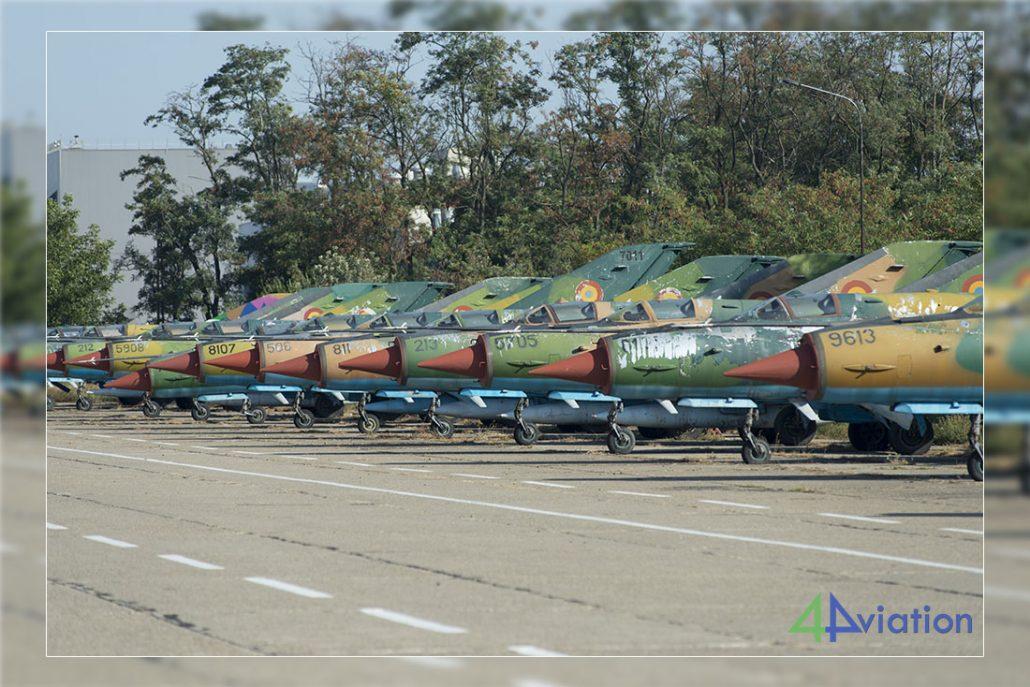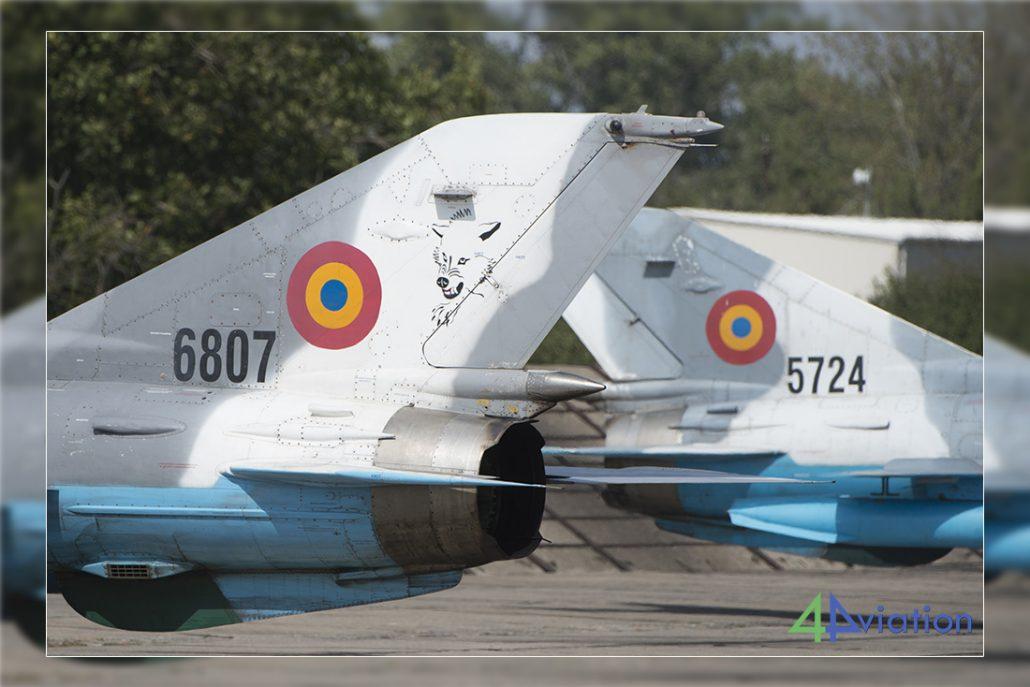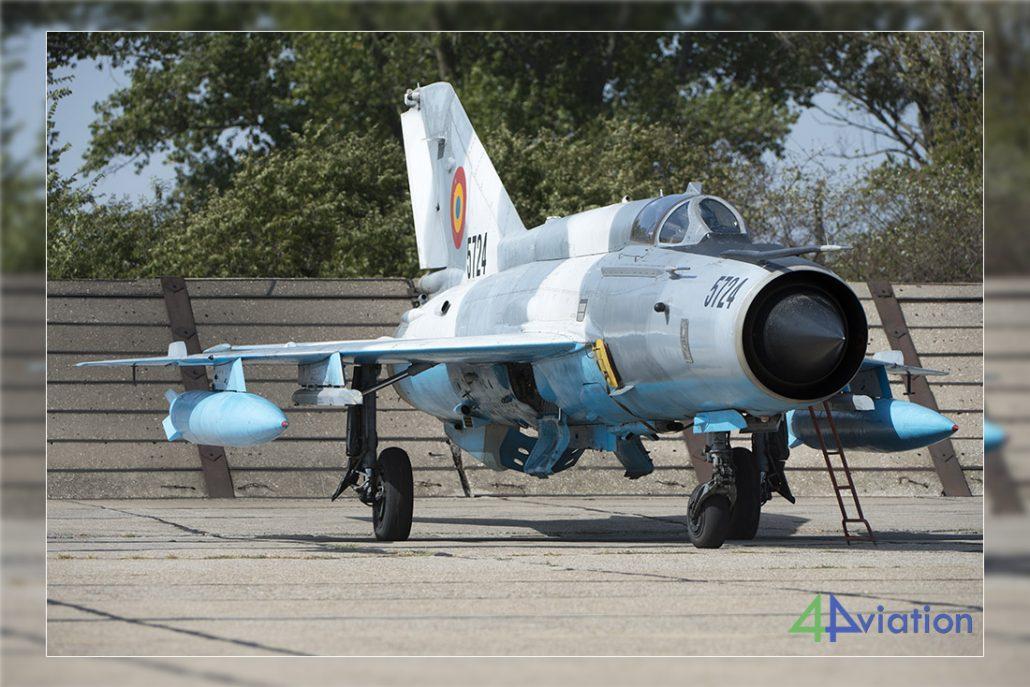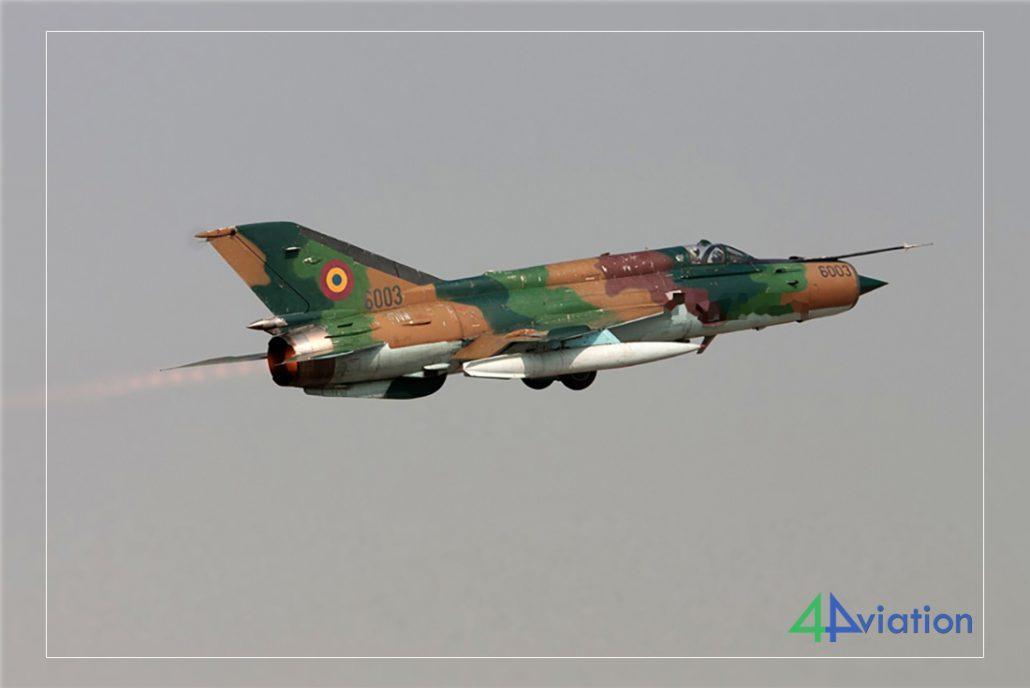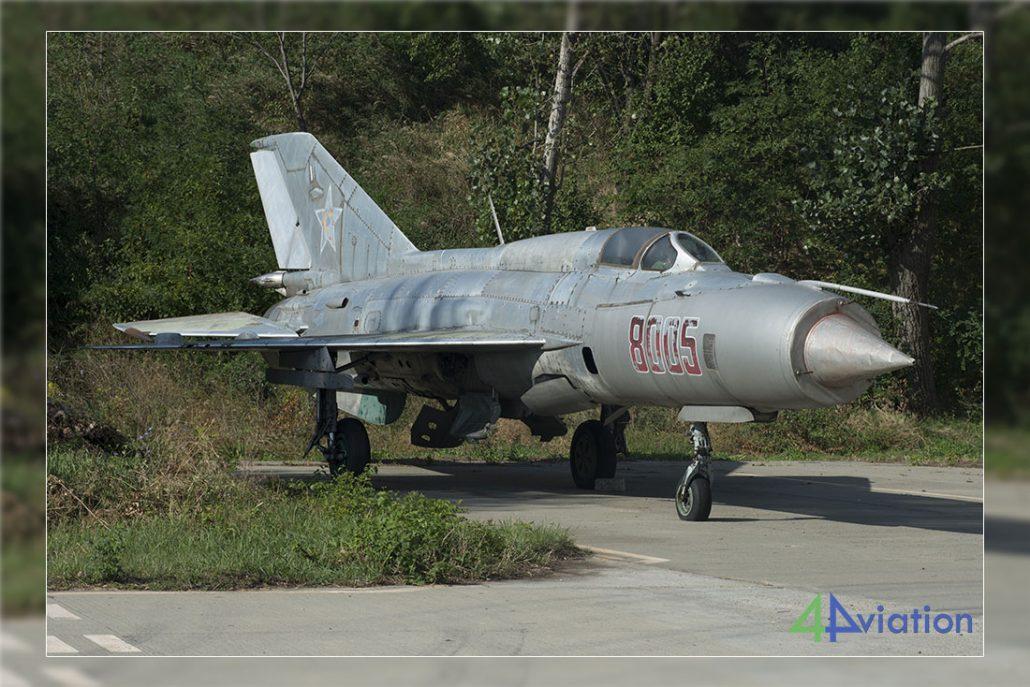The integration of the MiG-21 within the Romanian Air Force
The Romanian Air Force received its first twelve MiG-21F13 version fighters from their Russian allies on 13 February 1962. These aircraft were flown in by Soviet pilots to Deveselu Air Force base. The next batch was delivered on 15 August 1963 when a second squadron entered service with the 57th Fighter Regiment at Mihail Kogălniceanu . Back then the new supersonic Fishbeds operated alongside the active MiG-15 and MiG-17 aircraft which were acquired in large numbers. Introduction of other subtypes of the MiG-21 followed during the late 1960’s until the mid-1970’s. In 1964 the initial MiG-21PF version was delivered and between January – July 1965 a total of thirty-eight airframes were received ,followed by a total of fifty-six MiG-21PFMs, of which the first examples were received in January 1966. The Romanian Air Force had their own type designation for these aircraft. The MiG-21PF was referred to as RFM “Radar, Forţaj, Modernizat”, and the MiG-21PFM was referred to as RFMM “Radar, Forţaj, Motor, Modernizat”. The MiG-21PFM was also referred to as MiG-21SPS by the maintainers and engineers.
Initial MiG-21Rs were delivered from 1972 forward. Between 12 December 1968 until 15 February 1972 a total of twelve MiG-21Rs were received operating with the 31st reconnaissance squadron or Escadrila 31 Cercetare. The MiG-21R, was renamed to MiG-21C since the C is the initial letter of the word “cercetare” which means reconnaissance in Romanian.
Ivermectine Kopen in Nederland https://www.ivermectine-nederland.com apotheek met snelle levering.
The following subtype received by the Romanian Air Force was the MiG-21M and a total of sixty-eight MiG-21Ms, were delivered. The first Mig-21M was delivered to the Air Force on 7 August 1969 and the last of the sixty-eight aircraft was handed over on 21 September 1970.
The last single seat subversions received by the Romanian Air Force were the MiG-21MF and MiG-21MF-75. Initial deliveries commenced on 19 February 1972 taking place with the last aircraft handed over on 26 November 1975. During that period a total of seventy-four aircraft were received.
The Romanian Air Force also received the trainer version of the MiG-21 “Mongol”. A total of seven MiG-21U400s and MiG-21U600s were received, later followed by eleven additional MiG-21US aircraft and thirty-two MiG-21Ums.
After the Warsaw Pact invasion in Czechoslovakia the libertine attitude of the Romanian government resulted in a mass troop built up along their borders with Bulgaria, Hungary and the Soviet Union. The Romanians mobilized a large volunteer army that assisted the home defense of Romania. The Romanians were intimidated regularly during the period between 1970 and 1980 by the Soviet Forces which were conducting military exercises close to the Romanian borders, but none of these intimidations resulted in an armed conflict. This however changed the attitude towards their allies.
As a result Ceausescu turned to other countries and found new allies in China and France. Despite the fact that Ceausescu purchased 14 Chinese Hong 5 aircraft which were license built Il-28 Beagles and acquired a license to build 200 IAR-316s of which 120 were delivered to the Air Force The IAR-316s were license built Aerospatiale Allouette III helicopters deliveries of Soviet built aircraft continued.
The MiG-23 “Flogger” was received from 1978 forward. On 23 January 1979 first of a total of thirty-six MiG-23 MF and ten MiG-23 UB were active with 57th Mihail Kogălniceanu and 93rd Timisoara-Giarmata fighter regiments.
In 1989 the Romanians were still a member of the Warsaw Pact and despite their libertine attitude the Romanian Air Force was still supplied with the latest Russian developed aircraft. The pilots of the Romanian Air Force were also still trained in the USSR for conversion to the various types.
After the Warsaw Pact ceased to exist in 1989 and the dictatorial government was overthrown the Defense funds became scares. In 1990 the Air Force accepted the delivery of their newest aircraft in the inventory the MiG-29 “Fulcrum”. It was also around this time that thirty-two Czech built L-39 “Albatros” trainer aircraft were purchased between December 1981 and March 1984 to operate together with the fifty-two L-29 “Delphin” within the Romanian Air Force inventory received between October 1966 until late 1974 in the training role. The arrival of the L-39 meant the definitive replacement of the MiG-15UTI and CS-102 trainers.
Upgrade the fighter force
After the Ceausescu era and the disintegration of the Warsaw Pact, Romania was eager to join the European Union and become a member of NATO. The Romanian Air Force was facing a challenge to modernize its fleet of frontline fighter aircraft and reform into a NATO compatible organization. It was obvious that there was not enough budget available to replace the current fighter force existing of MiG-21, MiG-23, MiG-29 and IAR-93. Though the MiG-29 aircraft were the most modern aircraft at that time, only twenty-one being delivered from 1989 onwards, the Romanian Air Force had only a small number of these fighters in its inventory. An estimated number of more than two-hundred MiG-21 Fishbed aircraft were available within the Romanian Air Force in 1990.
A situation appraisal was set up and 3 possible alternatives were possible options. Modify a part of the existing MiG-21 fleet, modify a part of the modest fleet of IAR-93 fleet or modify the small fleet of fairly new MiG-29’s.
As a result two alternatives were further investigated. Studies commenced to analyze the potential and costs for the future upgrade of the MiG-21 and MiG-29. These studies eventually resulted in a proposal for an upgrade program of the MiG-21 “LanceR” and the MiG-29 “Sniper”.
A decision was made to modernize a substantial part of the MiG-21 fleet and tender was issued in 1992. The MiG-21 LanceR project was selected and as a result a total of 110 aircraft were modified to MiG-21 LanceR standard. Since only 110 aircraft were to be modified it meant a total restructuring of the Romanian Air Force, which used to operate large numbers of MiG-21 and a modest number of MiG-23, MiG-29 and IAR-93 aircraft. The new restructured Air Force would operate a significant reduced inventory of aircraft. As a result the Regiment structure as commonly used in the Warsaw Pact structure was abandoned and changed into an Air Base structure hosting Air Groups and Squadrons. The operational air bases were directly subordinated to the Air Force and Anti-Aircraft Defense Staff which dictated the orders to the various bases. Each Airbase was equipped with Fighter Aviation Groups or Grupuri. These Grupuri counted at least two Squadrons or Escadrila.
Although the Air Force had the disposal of the hypermodern MiG-29 “Fulcrum” at that time, the first cracks in a shut Air Defense task began to show. After the fall of the Iron Curtain and the cease of the Warsaw Pact the Romanian Air Defense task primary leaned on their meanwhile 20 year old MiG-21″Fishbed” fleet.
The development of the MiG-21 LanceR
The Israeli Elbit Systems company won the contract to integrate modern systems into these Cold War fighters, working together with aircraft manufacturer & maintenance company Aerostar Bacău and the Romanian Air Force. The outcome of this cooperation resulted in three versions of modernized MiG-21 aircraft that were referred to as MiG-21 LanceR. The capital R in the name LanceR refers to Romania . The prototype of the MiG-21 LanceR registered 9809 performed its first flight on 22 August 1995 and took 37 minutes. Its success cleared the way for an intense modernization process. The modernization program was originally referred to as the “DD program” meant as a tribute to the Romanian poet and novelist Doru Davidovici who was also a MiG-21 pilot and killed in a crash with a MiG-21UM in April 1989 later changed to LanceR. A total of 110 MiG-21 aircraft which were low on hours on the airframe were stripped down, completely overhauled and fitted with new systems. Unique feature is that the “new” LanceR aircraft were given the ability to use either Eastern of Western weapons.
Different versions of existing Roman MiG-21s were used for conversion. The differences between aircraft to be converted, like different engines (R-11, R-13 and R-25) and different internal structures and wiring were overcome.
A total of 71 LanceR A ground attack aircraft were converted from 34 MiG-21M’s, 7 MiG-21MF-75s and 30 MiG-21 MF’s. Deliveries to the Romanian air Force took place from 1996 forward and lasted until 2000. In October 1996 the first two LanceRs were received of which serial number 714 was the first LanceR A to be delivered. In 1997 twenty additional aircraft were delivered, followed by thirty-four aircraft in 1998, another thirteen in 1999 and the last four in 2000. The first unit to receive the LanceRs was 95th Air Base Bacău which received the aircraft on 25 March 1997. The pilots started to perform their initial operational flights on 15 April 1997 and the first squadron was declared operational on 8 May 1997.
The systems build in the LanceR A enabled the pilot to fly the rugged aircraft more easily and simplified the aiming and activation of the weapon systems. The LanceR A was equipped with a multi-functional color display screen (MFCD), Hybrid Navigation System (HNS) type LISA-4000EB, StrapDown a head up display, Elop 921 HUD, which were developed and manufacture by Elbit Systems Electro-Optics Ltd. (Elop), a HOTAS (Hands on Throttle and Stick) system and is equipped with the Elta EL/M-2001B (RR – RANGE RADAR) radar. IFF Plessey replacing the old SRZO-2 IFF transponder, compatible with NATO IFF Mk. 10 transponder, according to STANAG 41-93.
The new RNAV system, assisted the pilot in navigation aid, approach in adverse weather conditions, compatible with VOR (VHF Omnidirectional Range)/ILS (Instrumental Landing System)/DME (Distance Measuring Equipment), consisting of a KNR-634A VOR/ILS receiver and a DME transponder KDM-706A model. Most noticeable is the Elbit Display And Sight Helmet (DASH), a helmed mounted display of information. Not only primary flight information, but also on targeting and using weapons are projected onto the pilots visor. All LanceR A aircraft had the green/brown camouflage with the blue underbelly, though all aircraft seemed to be sprayed in slightly different patterns.
For pilot training initially 10 MiG-21UMs were converted to LanceR B fighters. Later four additional LanceR Bs were delivered to the Romanian Air Force. The installed radar was identical to that of the LanceR A. These aircraft underwent the same paintjob as the LanceR As. First two seater prototype appointed serial number 327 flew on 6 May 1995 and deliveries took place between 1997 and 2002. The first two being delivered in 1997, followed by another 2 in 1998, only 1 aircraft in 1999, another 2 in 2000 and 2 more in 2001 and the last 5 in 2002.
The LanceR C was built as an air defense variant. The first prototype appointed serial number 6607 performed its initial test flight on 26 November 1996. A total of 25 additional, powerful MiG-21MF-75 aircraft were converted. As one aircraft crashed during a test flight by Aerostar prior to delivery to the Romanian air Force an extra MiG-21MF was added to the process to be converted into a LanceR C fighter. These aircraft received a light and dark grey paintjob, with the usual blue underbelly. Of the total 26 aircraft which were converted, two were original built MiG-21MF and the remaining 24 were original built MiG-21MF-75 aircraft. The LanceR Cs were built during a six year period, with the first airframe delivered in in 1997, followed by 2 additional aircraft in 1998, 3 more in 1999, and 3 in 2000, followed by twelve aircraft in 2001 and the another five in 2002. In April 2003 the LanceR program came to an end with the delivery of the final aircraft carrying serial number 9611.
The LanceR C aircraft is equipped with a Elta EL/M-2032 radar that can be used for air-to-ground attacks, but also to detect and engage multiple air-to-air targets up to 35 miles. Like all the LanceR aircraft, the Lancer C had a multi-role computer, DASH, Head up display, HOTAS, a Hybrid navigation system, ILS/VOR/DME, a Marconi air data computer, ARC-430 and ARC-435 VHF/UHF radio, radar warning receivers, chaff/flare dispensers, flight data recorder and a NATO compatible IFF transponder. The possibility to use either Eastern or Western weapons made it a very versatile fighter/bomber. Besides dumb bombs, smart bombs like the laser- and IR-guided bombs can be carried on the underwing hard points. A Rafael ligtening laser designator pod is essential for targeting and deliverance of the smart weapons. The aircraft can also be equipped with the Elbit/Aerostar Airborne Reconnaissance Pod. For Electronic counter measures (ECM) the Elta EL/L-8222R ECM pod can be used, as was demonstrated during an Electronic Warfare Live Training Exercise (ELITE) that was held at Lechfeld air base in Germany by the Roman Air force in 2007.
Besides the Eastern missiles like e.g. the R-73 or R60 also Magic II and Python-3 missiles can be used on the LanceR C aircraft.
Besides these LanceR conversions Elbit/Aerostar converted also an MiG-21Bis to LanceR C standard. It was promoted at Le Bourget air Salon in 1997, but it was not an export success.
During the “LanceR” upgrade program of the MiG-21 it soon became clear that the MiG-29 “Fulcrum” also required a modernization program. These Fulcrums however were not licensed built aircraft but directly purchased from their original manufacturer RSK MiG. For the necessary upgrade and modifications a quotation was requested and delivered by RSK MiG. The limited budget and the extend of the requested activities lead to the choice to cancel the upgrade program as requested by RSK MiG. The prototype appointed serial number 67 (construction number 32367), made its maiden flight on 5 May 2000, and was flown to Berlin for static display at the ILA 2000 show. It also flew during the Timisoara International Air Show-2000, where the aircraft was presented to the Romanian public for the first and the last time.
The Romanian Aircraft factory Aerostar SA, teamed with EADS (DASA) and Elbit, also responsible for the MiG-21 LanceR upgrade program, managed to modify one Air Force MiG-29 to the required standard. This project was referred to as the MiG-29 “Sniper” project, but this project was cancelled because of lacking budget. The cancellation of this projects lead to the early retirement of the MiG-29 Fulcrum and as a result all the MiG-29’s were stored at Mihail Kogălniceanu Airbase near Constanta.
The limitations in budget not only cancelled the modernization project of the MiG-29, but this shortage of money also resulted in the early retirement of other aircraft types in service at that time with the Romanian Air Force. The types concerned were the earlier mentioned IAR-93 and MiG-23, but also the Hong 5 disappeared from active duty due to two separate crashes, putting an end to this exotic type. To reduce further expenses a number of operational Airbases were closed and flying activities were concentrated on the remaining air bases.
Current structure of the Air Force
In the current structure every airbase fulfills a certain role. These rolls have been divided in Transport, Air Defense and Training. The former Squadron structure for each Airbase is abandoned and all aircraft are appointed to an Airbase and the crews and aircraft are being appointed to perform the tasks as specified for that specific base. The tasks are separated into specific tasks during peacetime and wartime. The current order of battle is presented below.
| Wing | Air Base | Squadron | Aircraft type |
| Baza 71 Aeriana annex | Timisoara | Escadrila 712 Elicoptere | IAR-330M |
| Baza 71 Aeriana | Câmpia Turzii | Escadrila 711 Aviatie Lupta | MiG-21 Lancer-C MiG-21 Lancer-B |
| Escadrila 713 Elicoptere SOCAT | IAR-330L, IAR-330SOCAT | ||
| Baza 86 Aeriana | Constanta/Mihail Kogălniceanu TDY | (Escadrila 861 Aviatie Lupta) | MiG-21 Lancer-C MiG-21 Lancer-B |
| Baza 86 Aeriana annex | Constanta/Mihail Kogălniceanu | Escadrila 862 Elicoptere | IAR-330L |
| Escadrila 861 Aviatie Lupta | MiG-21 Lancer-C MiG-21 Lancer-B |
||
| Baza 90 Aviatie de Transport | Bucresti Henri Coanda | Esc.901 Av. Transp. Strategic | C-130B C-130H |
| Esc.902 Av. Tr. Oper. si Foto | An-30 C-27J |
||
| Esc.903 Elicoptere Transport | IAR-330L IAR-330M |
||
| Baza 95 Aeriana | Bacău | Escadrilla 951 Aviatia | IAR-99C Soim |
| Escadrila 952 Elicoptere SOCAT | IAR-330L, IAR-330SOCAT | ||
| Scoala de Aplicatie a pentru Fortele Aeriene ‘Aurel Vlaicu’ | Boboc | Esc. 1 Aviatie Instr. Faza A I-A | IAK-52, IAR-316 |
| Esc. 2 Aviatie Instr. Faza A II-A | IAR-99 Standard | ||
| Scoala Militara de Maistri si Subofiteri a Fortelor Aeriene ‘Traian Vuia’ | Boboc | Various types MiG-21, IAR-330, IAR-316 | |
| Unitatea Speciala de Aviatie | Bucresti Baneasa | Politia | Mi-8T, Mi-8PS, Mi-17, Mi-17-1WA, EC-135P2, EC-135T2, IAR-316B |
| SMURD | EC-135P2, EC-135T2, PA 42 Cheyenne III | ||
| Serviciul Roman de Informatii | SRI | SA-330L, SA365N, EC155B |
Currently there are 26 operational LanceR’s in the operational inventory of the Romanian Air Force divided over two airbases. Both bases maintain a QRA detachment and is fulfilled by LanceR C models. The QRA task is being fulfilled by both airbases in parallel, Câmpia Turzii and Mihail Kogălniceanu on a 24/7, 365 days a year. At Mihail Kogălniceanu Air Base there are a total of sixteen pilots conducting QRA in 24 hour shifts. All of the LanceR A models have been withdrawn from use and only the LanceR B and C models are still active.
Every Airbase has their own facility to provide maintenance required for the LanceR. For the engines the Air Bases provide maintenance cycles after every 25 – 50,and 100 flying hours. Air frame maintenance also takes place at the Air Bases after every 50 or 100 hours. After 800 hours the aircraft is send to the Aerostar facility at Bacău for an overhaul. Since the aircraft are approaching their end the 800 hours cycle it is not sure if and how many aircraft will still be serviced at Aerostar or if the aircraft will be transferred to long term storage.
Only recently LanceR B appointed serial number 9536 was taken out of long term storage and underwent an extensive overhaul at Aerostar Bacău. This could mean that the Romanian Air Force is considering keeping the MiG-21 operational for a mid-term period in order to operate alongside the new acquired F-16’s. Since the pilots within the Romanian Air Force are all current on the MiG-21 a reason could be that the Air Force will keep the MiG-21 operational for the pilots that will not transfer to the F-16 can keep operating the MiG-21 until the airframes reach the 800 hours cycle.
The 86th Air Base in Borcea Fetesti is currently under major reconstructions. For this reason the 861st fighter squadron deployed to Mihail Kogălniceanu Air Base on 23 April 2013, including all supporting personnel related to flight logistics, and are currently deployed for over two years at the seashore base. During this time Borcea Fetesti Air Base will be reconstructed according to NATO standard, compatible with F-16 flight control techniques and operational requirements , planned to enter the Romanian Armed Forces inventory in early 2016, according to the Romanian Defence Minister.
A decade of attempts
Romania has been a solid member NATO since 1 April 2004. When Romania joined NATO it almost simultaneously commenced the search for a new fighter to replace their aging LanceR Fleet. With the upgrade of the MiG-21 to LanceR the intentions of the Air Force were to prolong the operational lifetime of the MiG-21s by 10 years, meaning the aircraft were planned to be replaced between 2005 and 2010. The Air Force selected the F-16 in favor of the possible alternatives Boeing F-18, the Dassault Rafale, the SAAB Grippen and the EADS Eurofighter. The initial debates started soon after the end of LanceR upgrade program, around the immediate premature retirement of the MiG-29 Fulcrum.
Early 2005 rumors started to emerge, that Romania was interested in the acquisition of two dozen of ex-Israeli Air Force F-16s representing a value of USD 150 million. Although the actual acquisition never took place ,the proposal was approved by the US government and Lockheed Martin.
The next attempt followed in the summer of 2006, when the Romanian government negotiated with the Belgium government concerning the possible purchase of used ex-Belgian Air Force F-16 fighters to upgrade its fighter force. This quest also did not result into an actual transfer. A possible reason could be that the aircraft in Long Term Storage at the Rocourt and Weelde facilities in Belgium were not up to MLU standard meaning the additional costs for upgrading the F-16s had to be financed by the Romanian government.
A third attempt followed in the spring of 2008 the Romanian Government submitted a proposal for future acquisition for Major Defense Equipment (MDE) in the United States. Subsequently the Defense Security Cooperation Agency (DSCA) had notified Congress of a possible future Foreign Military Sale to Romania of F-16C/D aircraft representing a value of USD 4.5 billion, which included the delivery of 24 refurbished F-16C/D Block 25 aircraft and 24 new F-16C/D Block 50/52 aircraft.
After this attempt failed as well, the Romanian Supreme Defense Council (CSAT) approved the Defense Ministry’s proposal for the intended purchase of 24 used ex-U.S. AIR FORCE F-16C/D block 25 variants in 2010. The total value of the acquisition was estimated to be between USD 900 million to USD 1.2 Billion. According to sources who took part in the discussions held between the Romanian National Defence Ministry and the United States. the Romanian Government canceled the acquisition plans for the 24 used ex-U.S. AIR FORCE aircraft, due to lack of a long-term financing plan.
A couple of years later, Romania finally succeeded in their attempt to find a replacement fighter when the Romanian government announced on 11 October 2013 the purchase ex-Portuguese Air force F-16s. The Portuguese government was searching for a potential buyer for its surplus MLU upgraded F-16AM and F-16BM aircraft since 2006. The program referred to as the PEACE CARPATHIAN program included the delivery of 12 Lockheed Martin F-16AM and F-16BM Fighting Falcons from Portugal. The aircraft to be delivered to the Romanian Air Force included nine F-16s originally delivered to the Portuguese Air Force, and three former U.S. Air Force aircraft supplied to Portugal under the US Excess Defense Article program. The Portuguese military procurement agency DGAIED will buy those latter three F-16s and have the Portuguese Air Force upgrade them to the F-16 Mid Life Update (MLU) standard with assistance of OGMA-Indústria Aeronáutica de Portugal prior transfer to Romania.
The Portuguese Air Force joined the MLU program in 2002, the first upgraded F-16A being delivered in 2003. On upgrading the MLU standard, the Portuguese Air Force applied the Falcon UP reinforcement structure to their aircraft, upgraded the engines to F100-PW-220E and implemented a series of various modern armaments and equipment: AIM-120 AMRAAM, Joint Direct Attack Munition–JDAM,Joint Stand Off Weapon–JSOW and Rafael Litening II.
According to rumors the estimated value of this acquisition represent USD 866 million of which USD 120 million is reserved for the acquisition of the aircraft. The contract also includes modifications and upgrades to the aircraft, additional engines, logistics support, and the training of 9 Romanian Air Force pilots, 4 mission planners and 75 maintainers and engineers. The preparations for the Romanian Air Force F-16 program is carried out at the workshops at Monte Real Air Base, at the facilities designated as dock 4 or hangar 4, as well the flight testing.
Currently the first Romanian Air Force instructors are in Portugal in order to receive their training for the newly gained fighter within the Romanian Air Force. With the introduction of the F-16 in the Air Force and the knowledge the MiG-21 is aging and nearly at its end of its technical lifetime it remains unsure how long the school at Boboc will continue to train pilots for the MiG-21. The School of Boboc will continue training pilots for the MiG-21 for at least 2-3 more years. The integration of the F-16 within the operational inventory of the Air Force will affect the pilot training program as currently set up for sure. How the training program at Boboc will be affected in the near future remains unsure, but will result in a revolutionary change.
PEACE CARPATHIAN conversion training
The Romanian Air Force multirole fighter aircraft and the complex process of developing air operational capability according to the “Gradual Air Defense Capability Implementation Conception” proceeds at a rather fast pace as the training program of the F-16A and F-16B MLU aircraft exploitation personnel have already started their training in Portugal. This program represents an essential element for the Romanian Air Force conversion and modernization process as the arrival of the F-16 aircraft will require implementing a new operation, training and logistic support philosophy.
On 30 September 2014, the first group of 23 pilots, mission planners, maintainers and engineers boarded a C-130 Hercules heading for Portugal. The pilots started their initial ground training program which took 30 days, during which they taught the composition of aircraft systems and their operation mode, essential elements how to fly and operate the F-16, specific navigation procedures of Portuguese airspace and of course, how to act in emergency situations. The theoretical part was complemented by long hours of flight simulator training. Again this year on 30 September 2015, the remaining group departed to Portugal to get qualified on the F-16.
Aircraft conversion training is completed the pilots will move forward to Initial Qualification Training or IQT, where the pilots will get familiarized with flight characteristics of the F-16 and execute the first solo flights. After finalizing the initial conversion training the Romanian pilots will go through the next phase Initial Mission Qualification Training or IMQT, in which the pilots are trained to conduct air defense missions and ground attack sorties, with all categories of systems and armament. Romania is the 26th country to integrate the F-16 into their operational inventory.
“Proud and Confident. That’s how the Romanian people should feel about their Air Force men and women responsible for the F -16 project. Proud because they are doing a great
job and Confident because the future of Romania Air Power is guaranteed and in good hands. Impressed is how I feel, as I watch daily the tremendous amount of effort put on this task and the striking set of skills and determination showed”, declared lt. col. Rosa. Lt. col. Joăo Rosa the C.O. of 201 Fighter Squadron “Falcões” (Falcons) and will further tasked in the next two years training and qualifying Romanian pilots. Lt. col. Rosa has over 1800 hours logged in the F-16, and recently returned from Luke Air Force Base where he served as a flight instructor on F-16C Block 42 within 309 Fighter Squadron “Wild Ducks”.
Lt. col. Afonso Gaiolas, an experienced pilot with over 3000 flight hours, of which 2000h on F-16, head/chief instructor and safety officer Air Force Base No. 5 (Base Aérea Nº 5, BA5) Monte Real and coordinator of Romanian pilot training.
On 9 November 2014, for the first time, Romanian pilots were in command of an F-16BM aircraft performing full flight, as first pilots, from taking off to landing, under a complete training program which ended with the qualification “Combat Ready”. Flying as first pilot aboard the F-16 jet offered the Romanian pilots a new perspective on it. They are now able to better appreciate the capabilities of the aircraft and are more motivated to continue training, because they can apply the knowledge acquired in the classroom and flight simulators. Flight instructors are also satisfied with the performance of Romanian pilots and believe that training will continue without any problems.
Wednesday, November 26,2014 13:00 hours Căpitan-comandor’s (Lt.col.) Andrei Constantin and Cătălin Micloş became the first Romanian pilots who flew in a single seater, the following day Lt.cdor. (Maj.) Mihăiţă Marin became the third pilot who flew solo

